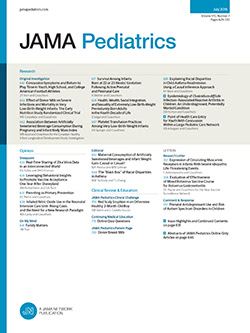Receipt of Federal Income Support by Eligible Low-Birth-Weight Infants
IF 24.7
1区 医学
Q1 PEDIATRICS
引用次数: 0
Abstract
ImportanceWhile many infants with low birth weight (LBW) are eligible for Supplemental Security Income (SSI), more evidence is needed about whether they receive benefits and whether income supports reach infants from the most socioeconomically disadvantaged households.ObjectiveTo assess receipt of SSI among LBW-eligible infants (infants eligible due to LBW) and targeting of SSI to LBW and income-eligible infants across county-level measures of socioeconomic disadvantage.Design, Setting, and ParticipantsThis cross-sectional study used administrative data from the SSI program, vital records, and the American Community Survey. It included a population-based sample of 185 920 LBW infants born between January 1, 2012, and December 31, 2018, from 482 US counties, with 2003 revised birth certificates, Social Security Administration–defined LBW, and survival of more than 31 days, and born in a county-year with at least 20 LBW infants surviving their first month of life. Analyses were conducted from January 1, 2022, to December 31, 2023.ExposuresThree measures of county-level socioeconomic disadvantage: poverty rates, median household income, and completion of postsecondary degrees.Main Outcomes and MeasuresReceipt of SSI among (1) infants who qualified due to LBW and (2) LBW- and likely income-eligible infants. In addition, whether receipt varied by county-level measures of socioeconomic disadvantage was evaluated using Poisson regression models.ResultsA total of 185 920 LBW-eligible infants were included in the study. During the study period, the proportion of LBW-eligible infants who received SSI was 0.38 (95% CI, 0.36-0.40). SSI receipt was higher in more disadvantaged counties measured by county poverty rates or median household income. After adjusting income eligibility, the proportion receiving SSI reached 0.65 (95% CI, 0.49-0.86). However, SSI receipt among LBW- and likely income-eligible infants decreased as the level of county socioeconomic disadvantage increased.Conclusions and RelevanceIn this cross-sectional study, most LBW infants who were eligible for SSI did not receive benefits. Likely income-eligible infants living in socioeconomically disadvantaged counties were covered by SSI at lower levels than those in more advantaged counties. More intensive outreach or reduced application burden may be necessary to ensure equitable access to social safety net programs in socioeconomically disadvantaged communities.求助全文
约1分钟内获得全文
求助全文
来源期刊

JAMA Pediatrics
PEDIATRICS-
CiteScore
31.60
自引率
1.90%
发文量
357
期刊介绍:
JAMA Pediatrics, the oldest continuously published pediatric journal in the US since 1911, is an international peer-reviewed publication and a part of the JAMA Network. Published weekly online and in 12 issues annually, it garners over 8.4 million article views and downloads yearly. All research articles become freely accessible online after 12 months without any author fees, and through the WHO's HINARI program, the online version is accessible to institutions in developing countries.
With a focus on advancing the health of infants, children, and adolescents, JAMA Pediatrics serves as a platform for discussing crucial issues and policies in child and adolescent health care. Leveraging the latest technology, it ensures timely access to information for its readers worldwide.
 求助内容:
求助内容: 应助结果提醒方式:
应助结果提醒方式:


